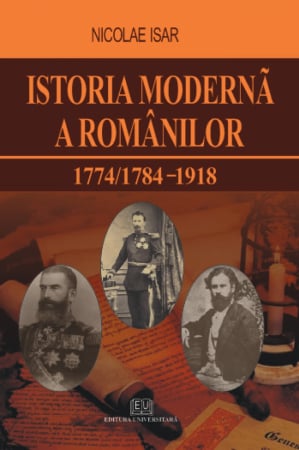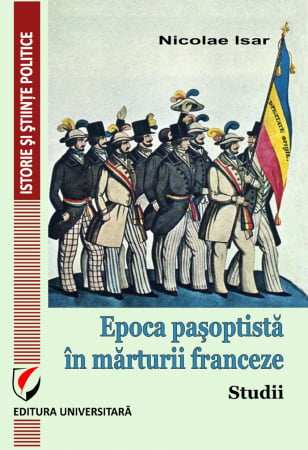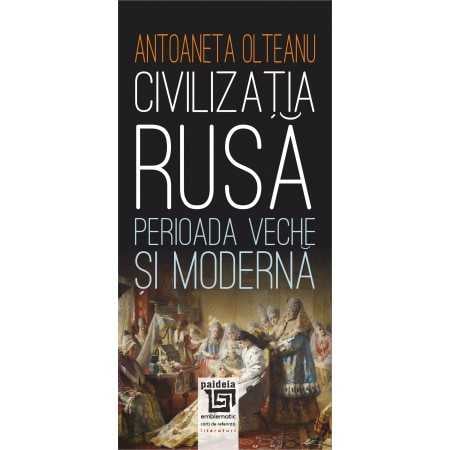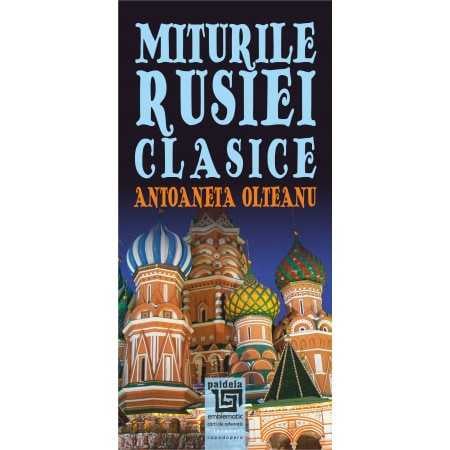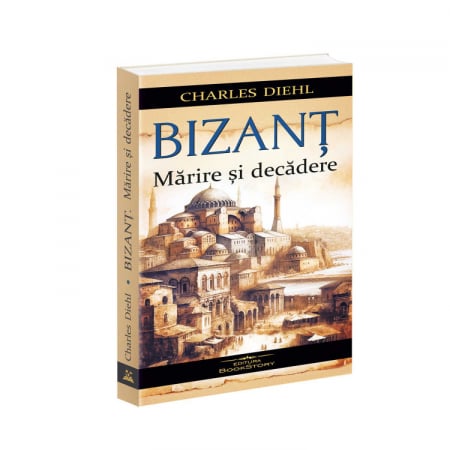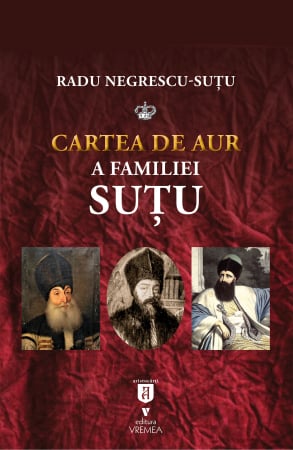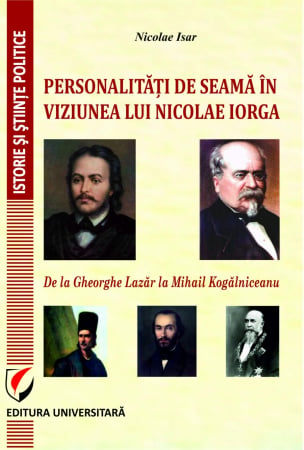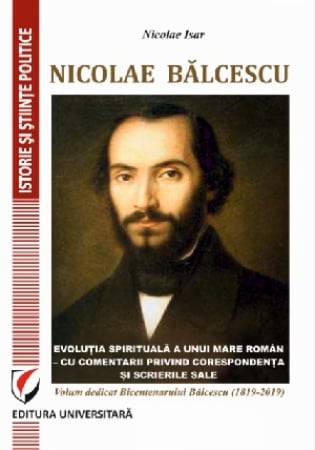Manuscript proposals: [email protected] / 0745 204 115 //// Tracking orders Individuals / Sales: 0745 200 357 / Orders Legal entities: 0721 722 783
Publisher: Editura Universitară
Author: Eugen Podeanu
Edition: I
Pages: 174
Publisher year: 2024
ISBN: 978-606-28-1762-6
DOI: 978-606-28-1762-6
Product Code:
9786062817626
Do you need help?
0745 200 357
- Description
- Download (1)
- Authors
- Content
- More details
- Reviews (0)
In my capacity as a history teacher, I considered it my duty to gather as much as possible about the history of the Filipestii de Targ commune, the environmental conditions, the economic and social-cultural life, which I share with those interested in this area Prahoveanu, described by Nicolae Iorga at the beginning of the 20th century as "a market similar to Valenii de Munte in its patriarchal appearance, in its Christian and Romanian peace and quiet".
Eugene Podeanu
Eugene Podeanu
-
Filipestii de Targ - Prahova. Monography
Download
PROF. EUGEN PODEANU was a teacher of the Filipestii de Targ General School for 41 years and director of the institution, between 1990-2011. Graduated in history-geography, Professor Podeanu is passionate about investigating and analyzing historical sources that provide information about the evolution of the communities in the Prahova area. His research contributed to the discovery and promotion of the history of an old Wallachian commercial center, in the development of which the Cantacuzino and Filipescu boyar families were involved.
INTRODUCTION / 7
CHAPTER I - GEOGRAPHICAL CHARACTERISTICS / 9
1. GEOGRAPHICAL POSITION AND NEIGHBORS OF THE MUNICIPALITY OF FILIPESTIA DE TARG / 9
2. PHYSICAL-GEOGRAPHIC CHARACTERIZATION / 10
A. Geological structure / 10
B. Relief and underground resources / 13
C. Climate / 16
D. Hydrography / 19
E. Vegetation / 22
F. Fauna / 25
G. Soils / 26
CHAPTER II - HISTORICAL MARKINGS / 28
1. THE BEGINNINGS OF THE SETTLEMENT OF PHILIPPESTIA DE TARG / 28
2. THE SETTLEMENT OF PHILIPESTI IN THE 17TH CENTURY / 36
3. THE APPEARANCE AND DEVELOPMENT OF THE FAIR IN THE 18TH CENTURY / 54
A. The evolution of the Filipesti fair in the 18th century / 54
B. The boyar families in Filipesti after 1716 / 57
4. THE EVOLUTION OF THE LOCATION OF PHILIPESTIA DE TARG IN THE 19TH CENTURY AND IN THE FIRST HALF OF THE 20TH CENTURY / 61
5. THE LOWER MARGINS / 74
A. Brief historical data / 74
6. BRACELET - short presentation / 82
CHAPTER III - THE SCHOOL IN PHILIPPESTIA DE TARG / 91
1. History of the school / 91
2. School premises / 94
3. Frequency / 100
4. Teaching staff / 103
5. School graduates / 113
6. Material base / 117
7. The contribution of the school to the social-cultural life of the locality / 122
CHAPTER IV - FAIR FAIRS - ADMINISTRATIVE- TERRITORIAL, DEMOGRAPHIC, ECONOMIC AND SOCIO-CULTURAL DATA / 126
1. Demography / 131
A. Work force / 135
B. Mobility of the population / 137
C. Economic activity / 138
a. Agriculture / 138
b. Industrial-craft activity, services and consumption / 142
2. Building endowments / 148
3. Cultural-artistic and sports-tourist life of the commune / 149
CONCLUSIONS / 154
BIBLIOGRAPHY / 155
IMAGES FROM THE COMMUNITY / 160
CHAPTER I - GEOGRAPHICAL CHARACTERISTICS / 9
1. GEOGRAPHICAL POSITION AND NEIGHBORS OF THE MUNICIPALITY OF FILIPESTIA DE TARG / 9
2. PHYSICAL-GEOGRAPHIC CHARACTERIZATION / 10
A. Geological structure / 10
B. Relief and underground resources / 13
C. Climate / 16
D. Hydrography / 19
E. Vegetation / 22
F. Fauna / 25
G. Soils / 26
CHAPTER II - HISTORICAL MARKINGS / 28
1. THE BEGINNINGS OF THE SETTLEMENT OF PHILIPPESTIA DE TARG / 28
2. THE SETTLEMENT OF PHILIPESTI IN THE 17TH CENTURY / 36
3. THE APPEARANCE AND DEVELOPMENT OF THE FAIR IN THE 18TH CENTURY / 54
A. The evolution of the Filipesti fair in the 18th century / 54
B. The boyar families in Filipesti after 1716 / 57
4. THE EVOLUTION OF THE LOCATION OF PHILIPESTIA DE TARG IN THE 19TH CENTURY AND IN THE FIRST HALF OF THE 20TH CENTURY / 61
5. THE LOWER MARGINS / 74
A. Brief historical data / 74
6. BRACELET - short presentation / 82
CHAPTER III - THE SCHOOL IN PHILIPPESTIA DE TARG / 91
1. History of the school / 91
2. School premises / 94
3. Frequency / 100
4. Teaching staff / 103
5. School graduates / 113
6. Material base / 117
7. The contribution of the school to the social-cultural life of the locality / 122
CHAPTER IV - FAIR FAIRS - ADMINISTRATIVE- TERRITORIAL, DEMOGRAPHIC, ECONOMIC AND SOCIO-CULTURAL DATA / 126
1. Demography / 131
A. Work force / 135
B. Mobility of the population / 137
C. Economic activity / 138
a. Agriculture / 138
b. Industrial-craft activity, services and consumption / 142
2. Building endowments / 148
3. Cultural-artistic and sports-tourist life of the commune / 149
CONCLUSIONS / 154
BIBLIOGRAPHY / 155
IMAGES FROM THE COMMUNITY / 160
The evidence of material and spiritual culture existing throughout our homeland speaks eloquently about our troubled history, about our people who created beauties and riches that few have enjoyed, regardless of the historical eras that have passed. These evidences offer the possibility of knowing the important moments in the history of our people, as well as the degree of culture in each historical stage.
In Prahova county, as in our entire country, the people and their most important representatives have created, despite all the hard times they have gone through, many material and spiritual values with deep patriotic meanings, a priceless treasure in which so many are reflected pages from the centuries-old history of the Romanian people.
In this context, the commune of Filipestii de Targ, through its heritage of monuments, occupies a significant place in the area of vestiges of the material and spiritual culture of Prahova county and of our country. Due to its location in the mouth of the Prahova valley at the exit from the Subcarpathian area, on the "old road" (or "dominiei road") of trade with Transylvania and quite close to Targoviste (the old capital of Romania), the towns of Filipestii de Targ and Marginenii de Jos appeared early and had a common evolution.
On their territory you can see vestiges of historical interest, such as:
- traces of the old noble houses in Margineni;
- the ruins of the Palace of the postman Constantin Cantacuzino from Filipesti (built in the first half of the 17th century);
- the Pana Filipescu mansion, built in the second half of the century. the 17th, which became the "Pana Filipescu Mansion" Museum;
- The tombstone of the Vintila commissar from the century. the 16th, today at the Museum of History and Archeology of Prahova County (written in Slavonic);
- the writing (written in Romanian with Cyrillic letters) and the foundation of the Dormition of the Virgin Mary church, founded in 1642 by the postman Constantin Cantacuzino, the stolnic Dumitrascu Filipescu, the speechwriter Pana Filipescu and their wives;
- "Cross of merchants" erected by the postman Constantin Cantacuzino on the "road of the reign";
- the church from Marginenii de Jos that preserves parts of the painting made by the great painter Nicolae Grigorescu.
With the 18th century, the town of Filipesti developed a lot, becoming a flourishing market and, at the same time, the residence of the Filipesti net. Nicolae Iorga, our great historian, passing through Filipestii de Targ at the beginning of the 20th century, describes it in "Romania as it was until 1918", as ".... A country fair similar to Valenii de Munte in its patriarchal appearance, in its Christian and Romanian tranquility and peace".
I used a series of notes or works of intellectuals from the commune or who worked here, such as teachers Dumitru I. Constantin, Constantin Podeanu, Maria Poenaru, professor Ion Stan, priest Constantin Popescu, to whom I am grateful, but especially works of history and geography that refer to Filipestii de Targ, Marginenii de Jos and Bratasanca.
I do not claim that the present work, published for the first time in 2013 (Editor - TIPOGRAFIA INDEX MEDIA INFO GRUP) and revised in the years 2016‑2021, is a success in the matter, but, as far as possible, I tried to gather as much data as possible about the history of the settlement, environmental conditions, economic and social-cultural life, data to share with my fellow citizens, but also with others, interested in this Prahov area.
author
In Prahova county, as in our entire country, the people and their most important representatives have created, despite all the hard times they have gone through, many material and spiritual values with deep patriotic meanings, a priceless treasure in which so many are reflected pages from the centuries-old history of the Romanian people.
In this context, the commune of Filipestii de Targ, through its heritage of monuments, occupies a significant place in the area of vestiges of the material and spiritual culture of Prahova county and of our country. Due to its location in the mouth of the Prahova valley at the exit from the Subcarpathian area, on the "old road" (or "dominiei road") of trade with Transylvania and quite close to Targoviste (the old capital of Romania), the towns of Filipestii de Targ and Marginenii de Jos appeared early and had a common evolution.
On their territory you can see vestiges of historical interest, such as:
- traces of the old noble houses in Margineni;
- the ruins of the Palace of the postman Constantin Cantacuzino from Filipesti (built in the first half of the 17th century);
- the Pana Filipescu mansion, built in the second half of the century. the 17th, which became the "Pana Filipescu Mansion" Museum;
- The tombstone of the Vintila commissar from the century. the 16th, today at the Museum of History and Archeology of Prahova County (written in Slavonic);
- the writing (written in Romanian with Cyrillic letters) and the foundation of the Dormition of the Virgin Mary church, founded in 1642 by the postman Constantin Cantacuzino, the stolnic Dumitrascu Filipescu, the speechwriter Pana Filipescu and their wives;
- "Cross of merchants" erected by the postman Constantin Cantacuzino on the "road of the reign";
- the church from Marginenii de Jos that preserves parts of the painting made by the great painter Nicolae Grigorescu.
With the 18th century, the town of Filipesti developed a lot, becoming a flourishing market and, at the same time, the residence of the Filipesti net. Nicolae Iorga, our great historian, passing through Filipestii de Targ at the beginning of the 20th century, describes it in "Romania as it was until 1918", as ".... A country fair similar to Valenii de Munte in its patriarchal appearance, in its Christian and Romanian tranquility and peace".
I used a series of notes or works of intellectuals from the commune or who worked here, such as teachers Dumitru I. Constantin, Constantin Podeanu, Maria Poenaru, professor Ion Stan, priest Constantin Popescu, to whom I am grateful, but especially works of history and geography that refer to Filipestii de Targ, Marginenii de Jos and Bratasanca.
I do not claim that the present work, published for the first time in 2013 (Editor - TIPOGRAFIA INDEX MEDIA INFO GRUP) and revised in the years 2016‑2021, is a success in the matter, but, as far as possible, I tried to gather as much data as possible about the history of the settlement, environmental conditions, economic and social-cultural life, data to share with my fellow citizens, but also with others, interested in this Prahov area.
author
If you want to express your opinion about this product you can add a review.
write a review

6359.png)
![Filipestii de Targ - Prahova. Monography [1] Filipestii de Targ - Prahova. Monography [1]](https://gomagcdn.ro/domains/editurauniversitara.ro/files/product/large/filipestii-de-targ-prahova-monografie-959561.jpg)



